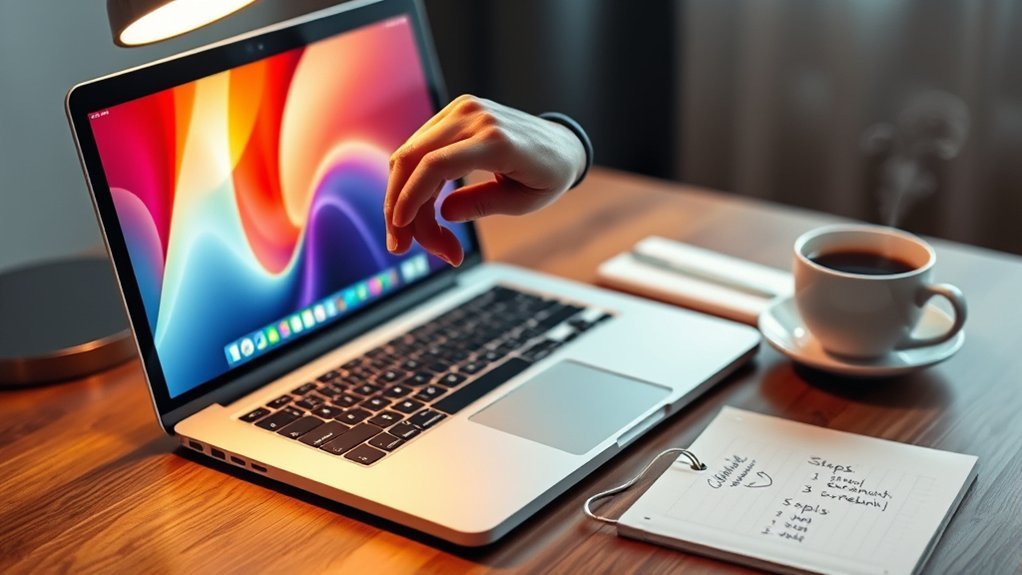Taking a screenshot on your MacBook is like capturing a fleeting moment in time; it freezes what’s on your screen for you to keep or share. Whether you need it for work, school, or personal use, knowing how to do this efficiently can save you time and hassle. In just five easy steps, you can master this useful skill. Ready to reveal the secrets behind those simple key combinations?
Understanding Screenshot Options on Your MacBook
When you want to capture your screen on a MacBook, you have several options at your fingertips. The most common choices include capturing a selected portion of your screen or a specific window.
Capturing your screen on a MacBook offers versatile options, whether it’s a specific window or a selected area.
By using keyboard shortcuts like Command + Shift + 4, you can easily draw a box around the area you want to capture. Alternatively, pressing Command + Shift + 5 opens a toolbar that offers more options, including recording your screen.
Each method empowers you to decide what to capture, allowing for greater control over your content. Understanding these options can liberate your creative process, enabling you to share ideas effortlessly.
Explore these tools and find what works best for your needs!
How to Capture the Entire Screen
To capture the entire screen on your MacBook, simply press Command + Shift + 3. This shortcut takes a quick snapshot of everything displayed on your screen. The screenshot will automatically save to your desktop, allowing you to access it easily.
| Step | Action | Result |
|---|---|---|
| Step 1 | Press Command + Shift + 3 | Entire screen captured |
| Step 2 | Locate the file on desktop | Screenshot saved |
| Step 3 | Open the file | View your screenshot |
| Step 4 | Edit if necessary | Customize your image |
| Step 5 | Share or save | Use your screenshot |
This method empowers you to document your screen effortlessly and share important information when needed. Enjoy your newfound freedom!
How to Capture a Selected Portion of the Screen
If you want to capture a specific area of your screen on your MacBook, you can easily do so by using a simple keyboard shortcut.
Press Command (⌘) + Shift + 4 simultaneously. Your cursor will turn into a crosshair.
Now, click and drag to select the portion of the screen you want to capture. As you drag, you’ll see a rectangle forming around your selection.
Click and drag to outline your desired screen area, watching a rectangle form around your selection.
Once you’ve highlighted the desired area, release the mouse button or trackpad. Your screenshot will be automatically saved to your desktop.
This method gives you the freedom to focus on just what you need, making it perfect for capturing snippets of information without clutter.
Enjoy the precision!
Saving and Editing Your Screenshots
Once you’ve taken your screenshot on a MacBook, it’s essential to know how to save and edit it effectively. Your screenshot automatically saves to the desktop by default, but you can change this in your settings if you prefer a different location.
To edit, open the screenshot by double-clicking it. You’ll find built-in tools in the Preview app that let you crop, annotate, or add text. Simply select the appropriate tool from the toolbar, make your adjustments, and save the changes.
If you want to share your screenshot directly, you can use the Share button in Preview to send it via email or social media. This way, you can liberate your creativity and express your ideas effortlessly!
Tips for Managing Your Screenshots
While managing your screenshots, it’s helpful to establish an organized system to keep track of them easily.
Start by creating designated folders based on categories like work, personal, or projects. This way, you won’t waste time searching for specific images later.
Use consistent naming conventions that include dates or keywords for quick identification. Regularly review your folders and delete any unnecessary screenshots to free up space.
If you use cloud storage, consider syncing your folders for easy access across devices.
Finally, make use of your MacBook’s built-in features like tagging to further streamline your organization.
Frequently Asked Questions
Can I Take Screenshots of Videos Playing on My Macbook?
Yes, you can take screenshots of videos playing on your MacBook. Just use the appropriate keyboard shortcut, and you’ll capture the moment. Remember, though, to guarantee you’re respecting copyright when sharing those images.
How Do I Change the Default Screenshot File Format?
You can change the default screenshot file format by opening Terminal and typing “defaults write com.apple.screencapture type [filetype]” (like png or jpg). About 70% of users prefer PNG for its quality. Don’t forget to restart!
Is There a Keyboard Shortcut for Taking Screenshots?
Yes, there’re keyboard shortcuts for taking screenshots. Press Command + Shift + 3 to capture the entire screen or Command + Shift + 4 to select a specific area. These quick commands simplify your screenshot process effortlessly.
Can I Capture Screenshots With a Third-Party App?
Yes, you can capture screenshots with third-party apps. They often offer advanced features, enhancing your ability to edit and organize images. Explore options like Snagit or Lightshot to liberate your screenshot experience and boost productivity.
How Do I Access My Screenshots Quickly?
You can quickly access your screenshots by opening Finder, selecting “Pictures,” and then the “Screenshots” folder. Alternatively, use Spotlight by pressing Command + Space and typing “Screenshots” for faster navigation. Enjoy the ease!
Conclusion
Now that you know how to take screenshots on your MacBook, you can capture the entire screen, select a specific area, save your images, and edit them seamlessly. Remember to organize your screenshots, share them easily, and enjoy the convenience they bring. With just a few keystrokes, you’re set to document and communicate effectively. So go ahead, take those screenshots, share your ideas, and showcase your creativity with confidence!

